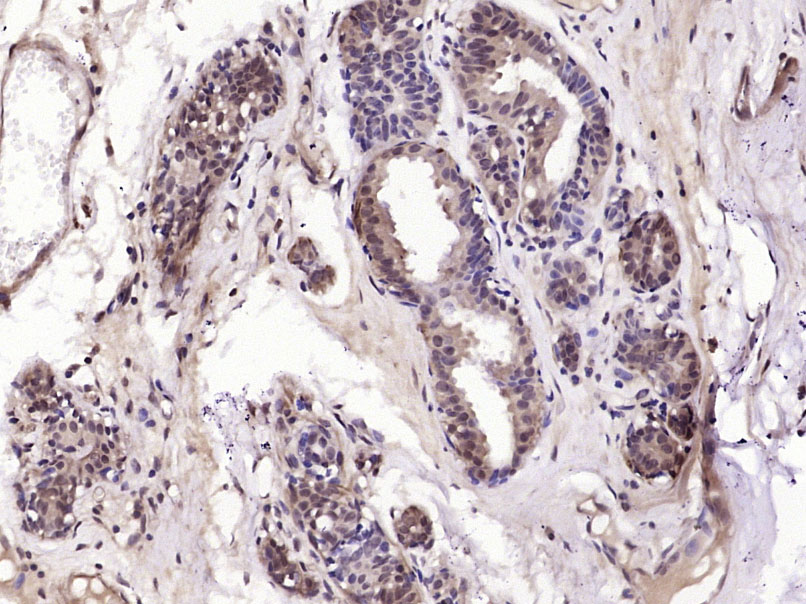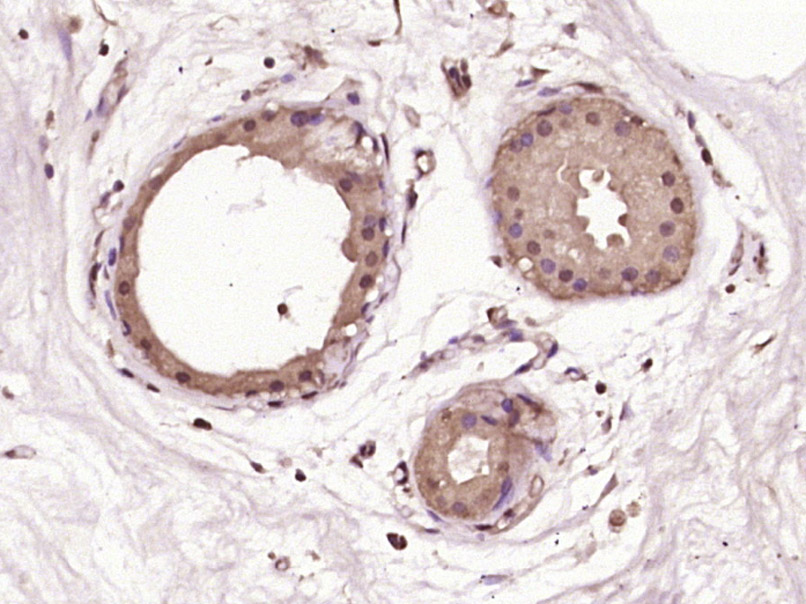
Rabbit Anti-ESE1 antibody
ELF3; E74 like factor 3; E74 like factor 3 ets domain transcription factor; E74 like factor 3 ets domain transcription factor epithelial specific; E74 like factor 3 ETS domain transcription factor serine box epithelial specific; E74-like factor 3; Elf3; E
View History [Clear]
Details
Product Name ESE1 Chinese Name epithelial cells特异性转录因子1抗体 Alias ELF3; E74 like factor 3; E74 like factor 3 ets domain transcription factor; E74 like factor 3 ets domain transcription factor epithelial specific; E74 like factor 3 ETS domain transcription factor serine box epithelial specific; E74-like factor 3; Elf3; ELF3_HUMAN; Epithelial restricted with serine box; Epithelial-restricted with serine box; Epithelium restricted Ets protein ESX; Epithelium specific Ets factor 1; Epithelium specific Ets transcription factor 1; Epithelium-restricted Ets protein ESX; Epithelium-specific Ets transcription factor 1; EPR 1; EPR1; ERT; ESE-1; ESX; Ets domain transcription factor serine box; Ets domain transcription factor serine box epithelial specific; Ets transcription factor; ETS-related transcription factor Elf-3; jen; MGC139318. Research Area transcriptional regulatory factor Cell differentiation Epigenetics Immunogen Species Rabbit Clonality Polyclonal React Species Human, (predicted: Mouse, Rat, Dog, Cow, Sheep, ) Applications WB=1:500-2000 ELISA=1:5000-10000 IHC-P=1:100-500 IHC-F=1:100-500 ICC=1:100-500 IF=1:100-500 (Paraffin sections need antigen repair)
not yet tested in other applications.
optimal dilutions/concentrations should be determined by the end user.Theoretical molecular weight 41kDa Cellular localization The nucleus cytoplasmic Form Liquid Concentration 1mg/ml immunogen KLH conjugated synthetic peptide derived from human ESE1: 201-300/371 Lsotype IgG Purification affinity purified by Protein A Buffer Solution 0.01M TBS(pH7.4) with 1% BSA, 0.03% Proclin300 and 50% Glycerol. Storage Shipped at 4℃. Store at -20 °C for one year. Avoid repeated freeze/thaw cycles. Attention This product as supplied is intended for research use only, not for use in human, therapeutic or diagnostic applications. PubMed PubMed Product Detail ESE-1, a member of the Ets family of transcription factors, critically regulates epithelial cell differentiation and mediates vascular inflammation. ESE-1 is strongly expressed in vascular endothelium and smooth muscle cells where it is induced in response to inflammatory cytokines and lipopolysaccharides, interacts with NF-KappaB to induce nitric oxide synthase, and is induced during terminal differentiation of epidermal and primary keratinocytes. In addition, ESE-1 is upregulated upon differentiation of corneal epithelium and interacts with Sp1 and AP-1 proteins to induce squamous differentiation marker expression in bronchial epithelial cells.
Function:
Transcriptional activator that binds and transactivates ETS sequences containing the consensus nucleotide core sequence GGA[AT]. Acts synergistically with POU2F3 to transactivate the SPRR2A promoter and with RUNX1 to transactivate the ANGPT1 promoter. Also transactivates collagenase, CCL20, CLND7, FLG, KRT8, NOS2, PTGS2, SPRR2B, TGFBR2 and TGM3 promoters. Represses KRT4 promoter activity. Involved in mediating vascular inflammation. May play an important role in epithelial cell differentiation and tumorigenesis. May be a critical downstream effector of the ERBB2 signaling pathway. May be associated with mammary gland development and involution. Plays an important role in the regulation of transcription with TATA-less promoters in preimplantation embryos, which is essential in preimplantation development.
Subunit:
Interacts with TBP. Interacts with CREBBP and EP300; these act as transcriptional coactivators of ELF3 and positively modulate its function. Interacts with XRCC5/KU86 and XRCC6/KU70; these inhibit the ability of ELF3 to bind DNA and negatively modulate its transcriptional activity. Associated with CLND7 and POU2F3.
Subcellular Location:
Cytoplasm. Nucleus. Localizes to the cytoplasm where it has been shown to transform MCF-12A mammary epithelial cells via a novel cytoplasmic mechanism. Also transiently expressed and localized to the nucleus where it induces apoptosis in non-transformed breast epithelial cells MCF-10A and MCF-12A via a transcription-dependent mechanism.
Tissue Specificity:
Expressed exclusively in tissues containing a high content of terminally differentiated epithelial cells including mammary gland, colon, trachea, kidney, prostate, uterus, stomach and skin.
Similarity:
Belongs to the ETS family.
Contains 1 ETS DNA-binding domain.
Contains 1 PNT (pointed) domain.
SWISS:
P78545
Gene ID:
1999
Database links:Entrez Gene: 1999 Human
Entrez Gene: 13710 Mouse
Omim: 602191 Human
SwissProt: P78545 Human
SwissProt: Q3UPW2 Mouse
Unigene: 67928 Human
Unigene: 441439 Mouse
Unigene: 3063 Rat
Product Picture
Bought notes(bought amounts latest0)
No one bought this product
User Comment(Total0User Comment Num)
- No comment




 +86 571 56623320
+86 571 56623320
 +86 18668110335
+86 18668110335

